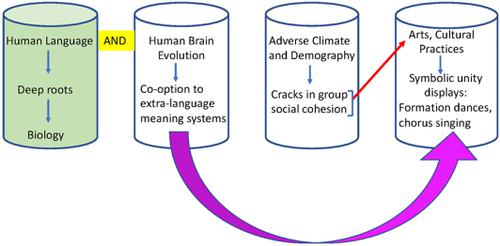当前位置:
X-MOL 学术
›
WIREs Cogn. Sci.
›
论文详情
Our official English website, www.x-mol.net, welcomes your
feedback! (Note: you will need to create a separate account there.)
Coevolution of language and symbolic meaning: Co-opting meaning underlying the initial arts in early human culture.
WIREs Cognitive Science ( IF 3.2 ) Pub Date : 2019-09-09 , DOI: 10.1002/wcs.1520 Dahlia W Zaidel 1
WIREs Cognitive Science ( IF 3.2 ) Pub Date : 2019-09-09 , DOI: 10.1002/wcs.1520 Dahlia W Zaidel 1
Affiliation

|
Many of language's components, including communicating symbolic meaning, have neurobiological roots that go back millions of years in evolutionary time. The intersection with the human social survival strategy spawned additional adaptive meaning systems. Under conditions threatening survival in socially oriented human groups, extra-language meaning systems co-opted and adapted to facilitate unity, including the early formats of the arts. They would have percolated into cultural practice for this social purpose and ultimately survival. With evolutionary pressures tapping into biologically inherited, physiologically functioning sensory-motor pathways, anchored specifically in rhythm cognition and motor synchrony output, initial art practice conveyed symbolic group cohesion through communal, all-inclusive synchronously moving dance formations and rhythmically produced vocal or percussion sounds. As with the sounds of language in the deep past, and numerous other cultural behaviors, such nonmaterial early art formats would not have left marks in the archeological record but their evolutionary driven practice would have contributed to adaptive genetic factors woven into brain-behavior evolution. Their practice is likely to have well predated unearthed art-related objects. Consolidation of evidence and notions from language evolution, genetics, human physiology, comparative animal communication, archeology, and climate history in the distant past of early humans in Africa supports the evolutionary driven practice of initial nonmaterial art formats conveying symbolic expressions optimizing group survival. This article is categorized under: Cognitive Biology > Evolutionary Roots of Cognition Linguistics > Evolution of Language Psychology > Comparative Psychology.
中文翻译:

语言和象征意义的共同进化:人类早期文化中最初艺术的潜在选择。
语言的许多组成部分,包括传达符号含义,都具有神经生物学的根源,可以追溯到数百万年的进化时代。与人类社会生存策略的交叉产生了更多的适应性意义系统。在威胁以社会为导向的人类群体生存的条件下,人们选择并改编了额外的语言含义系统,以促进统一,包括早期的艺术形式。他们将为此社会目的并最终生存而渗透到文化实践中。随着进化压力进入生物遗传的,具有生理功能的感觉运动途径,特别是基于节奏认知和运动同步输出,最初的艺术实践通过社区,团体,组织和团体传达了象征性的群体凝聚力。包罗万象的同步移动的舞蹈形式以及有节奏地产生的声音或打击乐声音。就像过去的语言之声和许多其他文化行为一样,这种非物质的早期艺术形式在考古记录中不会留下任何痕迹,但其进化驱动的实践将有助于将适应性遗传因素编织到大脑行为的进化中。他们的实践可能早于出土的艺术品相关物品。在非洲早期人类的遥远过去中,来自语言进化,遗传学,人类生理学,比较动物交流,考古学和气候史的证据和观念的合并,支持了最初的非物质艺术形式的进化驱动实践,传达了优化群体生存的符号表达。
更新日期:2019-09-09
中文翻译:

语言和象征意义的共同进化:人类早期文化中最初艺术的潜在选择。
语言的许多组成部分,包括传达符号含义,都具有神经生物学的根源,可以追溯到数百万年的进化时代。与人类社会生存策略的交叉产生了更多的适应性意义系统。在威胁以社会为导向的人类群体生存的条件下,人们选择并改编了额外的语言含义系统,以促进统一,包括早期的艺术形式。他们将为此社会目的并最终生存而渗透到文化实践中。随着进化压力进入生物遗传的,具有生理功能的感觉运动途径,特别是基于节奏认知和运动同步输出,最初的艺术实践通过社区,团体,组织和团体传达了象征性的群体凝聚力。包罗万象的同步移动的舞蹈形式以及有节奏地产生的声音或打击乐声音。就像过去的语言之声和许多其他文化行为一样,这种非物质的早期艺术形式在考古记录中不会留下任何痕迹,但其进化驱动的实践将有助于将适应性遗传因素编织到大脑行为的进化中。他们的实践可能早于出土的艺术品相关物品。在非洲早期人类的遥远过去中,来自语言进化,遗传学,人类生理学,比较动物交流,考古学和气候史的证据和观念的合并,支持了最初的非物质艺术形式的进化驱动实践,传达了优化群体生存的符号表达。











































 京公网安备 11010802027423号
京公网安备 11010802027423号